Gary McDonald Business Editor
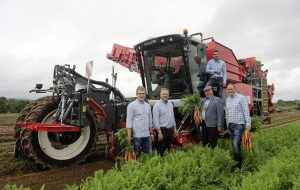
Some of the staff and pickers at work in the Gilpin farm in Armagh
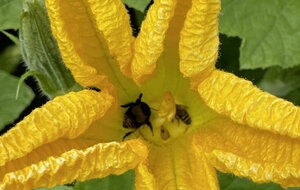
POLLINATOR: A bee inside a flower
NATURE – and the art of reproduction – is being given a helping hand in Co Armagh in a unique initiative where farmers are being assisted to track pollinators to maintain quality of produce and improve crop yields.
Retailer M&S is teaming up with agri-tech start-up AgriSound to provide in-field noise sensor technology to boost pollinator activity.
More than 70 per cent of the world’s food crops grown for human consumption rely on pollinators for sustained production, yield and quality.
And one of 18 sites across the UK chosen for the experiment is Gilpin Farms in Armagh, where sensors will be placed in its pumpkin patches.
Two in-field sensor trials were launched last year to help farmers better support pollinators like bumblebees and increase crop yields.
AgriSound technology allows farmers to track the number of pollinators visiting their farm in real-time and target specific interventions, like differing wildflower densities, for improving numbers and yields and quality of crops.
Now the technology is being scaled up across the UK to cover a diverse range of M&S’s fruit, veg and salad farms, with monitors covering 120 habitats and more than 1,000 hectares.
The technology will provide growers like Gilpins – which supplies M&S with carrots, leeks, pumpkins and Brussels sprouts – with access to real-time data and insights to help set their farms up to be more nature friendly.
Richard Gilpin, head of operations at Gilpin Farms, said: “The technology will be invaluable to help us monitor the pollinator activity across the whole farm, but particularly in the pumpkin crops.
“We currently bring in over 100 hives of bumble bees and honey bees to aid the pollination of the pumpkins, and the AgriSound technology will monitor how effective this is and also help us to make informed decisions about further interventions.
“We’re delighted to have been selected by M&S as one of the locations for this expansion and are excited to see what beneficial outcomes can be achieved by these relatively simple measures.
“If we can attract more pollinators to our farm, this will be a huge success.”
Andrew Clappen, technical director at M&S Food, added: “Improving biodiversity is at the forefront of our plans to help farmers become more resilient to the impact of climate change.
“Pollinators are the unsung heroes of farming – helping to improve yields and quality while benefitting the wider environment.”
We are here to share current happenings in the bee industry. Bee Culture gathers and shares articles published by outside sources. For more information about this specific article, please visit the original publish source: How technology is giving nature – and pollinators – a helping hand in Armagh – The Irish News
]]>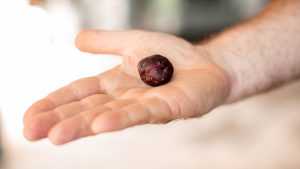
Propolis is a sticky resinous substance found in bee hives.
Beekeepers look to untapped potential of propolis, or ‘bee glue’, as alternative revenue stream
A by-product of honey production largely discarded in Australia could provide an alternative income source for beekeepers across the country.
Hidden within the walls of their hives, bees blend up a unique mix of materials that scientists believe holds untapped potential in Australia.
Propolis is a sticky, resinous substance that’s sometimes referred to as “bee glue”.
Bees use propolis as a powerful sterilising agent as well as to seal gaps in their hives against predators and the elements.
‘Propolis is used by the bees because they don’t have an immune system,” Queensland beekeeper Murray Arkadieff said.
“Bees forage within a 7 kilometre radius of the beehive, so that means they cover about 210km²,” he said.
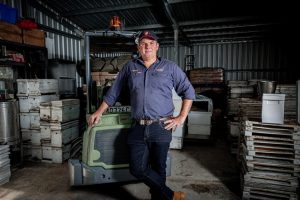
Murray Arkadieff has been a beekeeper his entire life.
Mr Arkadieff said the bees were able to look throughout that 210km² and search for parts of plants that could be used to polish their hives.
The bees not only forage for nectar and pollen, but also for other parts of the natural environment such as sap or bark.
“They bring that back to the beehive and they can mix it all together and it turns it into a really strong antimicrobial, anti-fungal, antiviral and antibacterial material, which they polish their entire hive with,” he said.
Propolis and its medicinal wonders
Propolis also has benefits for people and is used in many different countries in medicines, dietary supplements, and cosmetics.
“Propolis contains high polyphenolic compounds,” organic chemist from the University of the Sunshine Coast Trong Tran said.
“Australian propolis is very diverse and it also shows very comparable, even higher antioxidant activities compared with the other well-known propolis in the world, Dr Tran said”
Despite being part of a well-established industry elsewhere, in Australia there isn’t large-scale commercial propolis harvesting and processing.
“We’ve always mainly been focused on liquid honey production,” Mr Arkadieff said.
“It’s not something that Australians have looked into in a massive way, which is why it’s such an exciting opportunity for the industry.”
Peter Brooks is part of the research team from the University of the Sunshine Coast that has been part of the Australian Propolis Project, an initiative supported by the federal government’s Agrifutures organisation.
“When we started talking to beekeepers about what they were interested in they were saying: ‘Well this propolis product that they throw out, it’s got a lot of value, so how could we use that in some of our research?” Dr Brooks said.
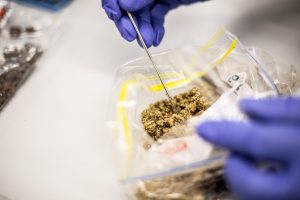
Samples of propolis were collected from different areas around the country and were sent to the lab to be analysed.
“Like everything, if you’re throwing something away that you could be making money for — it could be a new source of income.”
To begin with, scientists needed to ensure that Australian propolis was valuable, given its specific properties were largely unknown.
A buzzing opportunity for beekeepers
Hive and Wellness Australia, formerly known as Capilano, asked its 1,200 beekeepers nationally to consider participating in a trial collection of propolis.
Samples collected from all over the country were sent to the University of the Sunshine Coast for analysis.
“Of those samples that came back I think there was around 55 per cent that showed high antioxidant compounds,” said Jessica Berry, an industry liaison officer with Hive and Wellness Australia.
Dr Tran leads the research team, which is focused on finding out which samples hold the higher antioxidant value, and why.
He thinks one reason might be that about 80 per cent of Australia’s plants are endemic, and so aren’t found anywhere else.
“So we can expect that Australian propolis is unique to other areas in the world,” he said.
The complete article can be found at; https://www.abc.net.au/news/2023-07-23/australian-beehives-propolis-alternative-revenue-for-beekeepers/102625256o
We are here to share current happenings in the bee industry. Bee Culture gathers and shares articles published by outside sources. For more information about this specific article, please visit the original publish source: https://www.abc.net.au/news/2023-07-23/australian-beehives-propolis-alternative-revenue-for-beekeepers/102625256o
]]>Reuters
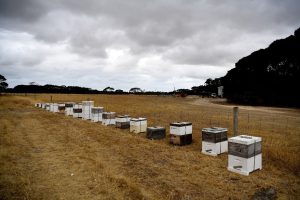
Bee hives at a farm on Kangaroo Island, Australia January 20, 2020. Picture taken January 20, 2020. REUTERS/Tracey Nearmy/File Photo
CANBERRA (Reuters) – The Australian government said it will stop trying to eradicate the Varroa mite, a parasite that kills honey bees, and will instead try to manage its spread, which is likely to make pollination of crops such as almonds more costly.
The decision ends an A$132 million ($85.3 million)eradication plan that has destroyed more than 14,000 hives in southeastern Australia since the mite was discovered there in June 2022.
The federal government said the decision was taken on Tuesday by the National Management Group (NMG), which is driving the Varroa programme nationwide.
In a statement on Wednesday, the New South Wales government, speaking on behalf of the NMG, said non-compliant and illegal movement of hives had spread the parasite further and made it impossible to contain.
Commercial crops including almonds, apples and avocados are dependent on pollination by European honey bees, with huge numbers of hives moved during spring flowering to bring bees to plants.
The Australian government has said a widespread mite infestation could destroy most wild European honey bee nests and managed hives not adapted to Varroa, reducing pollination and causing losses of over A$70 million a year.
“The recent spike in new detections have made it clear that the Varroa mite infestation is more widespread and has also been present for longer than first thought,” the New South Wales government said in a statement.
“The potential to eradicate is no longer possible… We now need to work collaboratively to manage and minimise the impact of Varroa.”
Varroa is a reddish-brown mite around 1 mm in diameter that attaches itself to European and Asian honey bees and feeds on them, weakening them and killing colonies.
The mite also carries viruses and has caused the collapse of honey bee populations around the world.
Varroa does not target native Australian honey bees.
We are here to share current happenings in the bee industry. Bee Culture gathers and shares articles published by outside sources. For more information about this specific article, please visit the original publish source: https://www.reuters.com/world/asia-pacific/australia-abandons-efforts-eradicate-deadly-honey-bee-parasite-2023-09-20/
]]>/ By Lucas Forbes, Bronwyn Herbert, Emily Doak, and Tina Quinn
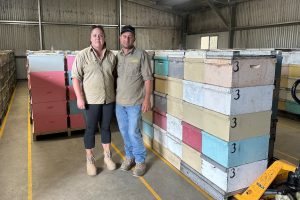
Beekeepers Denille Banham and Daniel Costa stand to lose all their hives due to varroa mite. (ABC News: Tina Quinn)
As authorities race to control the outbreak of varroa mite in Australia’s bee population, many beekeepers are saying it is time to learn to live with the mite.
Key points:
- A US bee health group is working on a “varroacide” to defeat the pest
- A New Zealand beekeeper says the worst effects of varroa mite were over in two years
- Beekeepers losing hives to euthanasia in Australia are calling for a policy shift from eradication to management
But what would that look like?
More than a year after varroa mite was first found at the Port of Newcastle, detections of the parasite have ramped up.
In recent weeks, thousands of beehives have been quarantined or euthanased after the mite was detected in hives in Kempsey on the NSW mid-north coast, many of which were delivered to parts of the Sunraysia and Riverina districts for almond pollination.
With Australia the only continent in the world where varroa has not taken hold, authorities have maintained a policy of eradication.
Varroa mites can destroy entire hives. (Supplied: Gilles San Martin)
For Kempsey beekeepers Denille Banham and Daniel Costa, the eradication strategy means their hives will be destroyed after varroa was found in some hives taken to Nericon, near Griffith, for the pollination season.
They have 750 hives in the eradication zones and 480 will have to be destroyed.
“Your 23 years of hard work, blood, sweat and tears, just all gone,” Mr Costa said.
Beekeepers are now calling for Australia to move towards managing the mite and living with it, instead of trying to eradicate it.
How is varroa mite managed?
The United States has been living with varroa mite since the late 1980s, when the pest was accidentally introduced to Florida.
The Honey Bee Health Coalition (HBHC) teaches beekeepers how to manage varroa mite and invests in research into developing pesticides that could kill the pest.
HBHC facilitator Matthew Mulica said varroa mite was so common in North America that if any hive did not have it now, it would within the next year.
That is why American beekeepers test for varroa two to four times a year.
If there are more than three mites per 100 bees, the coalition says beekeepers should start control measures immediately.
It is crucial to identify varroa to stop them spreading.
“If you do nothing, then in their last dying breath bees will fly off and infect other hives around you,” Mr Mulica said.
Regular testing carried out
One of the costs of management is hiring people to test hives and apply treatments.
Tumut beekeeper John Casey estimated his labour bill would double under a management policy, but said that would be preferable to staying with eradication.
“We’ve got 2,000 hives up at Euroley in the red zone. We don’t know if they’re going to let us move them or euthanase them,” he said.
“It’s a big loss of the bees and also the income we could make off them for the next couple of years.”
Hundreds of Belinda and John Casey’s hives have been impacted by measures aimed at controlling varroa mite. (ABC Rural: Emily Doak)
In the US, beekeepers can use chemical treatments to kill the mites, and there are some non-chemical techniques as well that interrupt the life cycle of the hive and slow varroa down.
Since varroa mite grows in the pupa of bees, producers can also remove the queen from the hive temporarily to reduce the number of pupa and cut down the opportunities for the mite to grow.
Mr Mulica said the HBHC was working with scientists in the US, Canada and Spain to create a “varroacide” to control the pest.
“We’re looking at all of these things and testing different compounds to find that next miracle molecule, if you will,” he said.
Varroa-resistant bees are also being developed which attack mites or kick infested bees out of the colony.
Silver linings in New Zealand
New Zealand beekeeper Barry Foster said the varroa mite outbreak in 2000 had put up to a third of beekeepers out of business, but there was a silver lining for those who remained.
Around the world varroa mites have killed off almost all the feral bees — the ones bred by beekeepers that escape into the wild.
Feral bees pollinate a lot of crops for free, but with fewer hives in the wild there is more demand for commercial pollination services, and that is what happened in New Zealand.
Mr Foster said beekeepers were paid more for their services and the industry recovered in just a couple of years.
“It was a fairly quick turnaround. Probably within a year or two we had gone through the most difficult learning and mental health period,” Mr Foster said.
He said the beekeeping industry had to adapt.
“You have to be a better beekeeper because of varroa and more on your game and better at planning,” he said.
We are here to share current happenings in the bee industry. Bee Culture gathers and shares articles published by outside sources. For more information about this specific article, please visit the original publish source: Bee pest varroa mite common in New Zealand and the US where beekeepers have learned to live with it – ABC News
]]>/ By Joanna Prendergast, Sophie Johnson, and Belinda Varischetti
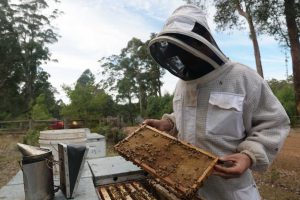
Pemberton beekeeper Mike Cernotta says WA needs to take the varroa threat more seriously. (ABC South West WA, Jon Daly)
West Australian honey producers say they are increasingly anxious about the spread of the destructive varroa mite across New South Wales and fear complacency has left the state’s industry ill-prepared for an outbreak.
Key points:
- As varroa spreads in NSW, the WA beekeeping industry is divided over whether eradication is still possible
- There are fears traffic moving from the east will inadvertently transport the destructive mite into WA
- But authorities say they are “incredibly confident” it can be kept out.
Varroa destructor attacks European honeybees and is regarded as one of the greatest threats to Australia’s honey and honey bee pollination plant industries.
It was detected in sentinel hives in NSW in June last year, but has spread to several new locations in recent weeks, prompting debate about whether eradication is possible, or if NSW should transition to a varroa management policy.
Pemberton beekeeper and WA Bee Industry Council vice chair Mike Cernotta said there was a “huge risk” of varroa entering WA through traffic on the east-west freight link or through swarms of feral bees, and the state was not prepared.
“We had a national blitz where we encouraged beekeepers all over the nation to do alcohol washes, which is the primary detection tool to look for varroa, and unfortunately the uptake in WA was relatively poor … I think it’s complacency,” he said.
“We are pleading with WA beekeepers to do the minimum.
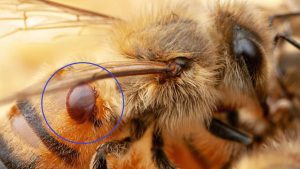
Varroa mite was first detected in Australian in June last year. (ABC Great Southern: Sophie Johnson)
“Time is ticking … the risk is growing, and we really need people to get serious about biosecurity, because otherwise we may find ourselves in a similar situation to NSW where we are scrambling to try and get on top of this pest. ”
Mr Cernotta said he supported eradication attempts continuing in NSW.
“I’d be lying if I said we didn’t have extreme levels of anxiety, because there is nothing we can do other than sit and watch,” he said.
“It’s devastating to see beekeepers facing [hive destruction], but the reality is they’re taking a hit for the rest of the nation’s beekeepers.”
Moving forward with varroa
Kim Fewster has been in the honey industry for 50 years, selling into a range of international markets…
To read the complete article go to; WA honey industry fears biosecurity ‘complacency’ has left state ill-prepared for a varroa mite outbreak – ABC News
We are here to share current happenings in the bee industry. Bee Culture gathers and shares articles published by outside sources. For more information about this specific article, please visit the original publish source: WA honey industry fears biosecurity ‘complacency’ has left state ill-prepared for a varroa mite outbreak – ABC News
]]> Canadian Governments Helping Grape Growers and Beekeepers Strengthen Their Businesses
Canadian Governments Helping Grape Growers and Beekeepers Strengthen Their Businesses
Canada and Ontario investing up to $10 million to support sectors hit by extraordinary weather conditions.
Agriculture, Food and Rural Affairs
TORONTO – The governments of Canada and Ontario are investing up to $10 million through the Sustainable Canadian Agricultural Partnership to help the grape growing and beekeeping sectors offset extraordinary costs caused by significant grapevine and bee colony losses due to extreme weather conditions in 2021-22.
Two new AgriRecovery initiatives will provide up to $5 million for eligible grape growers and up to $5 million for eligible commercial beekeepers.
“Resuming operations after disaster events can present extraordinary costs for beekeepers and grape growers,” said the Honourable Marie-Claude Bibeau, federal Minister of Agriculture and Agri-Food. “These initiatives will help to mitigate the impacts of these unanticipated occurrences so that these producers can recover and thrive.”
This July, eligible Ontario grape growers can apply for financial support under the Canada-Ontario Grapevine Winter Injury Initiative (2021-2022) to help recover from significant vine damage and loss. The damage resulted from a series of severe weather events including periods of drought, heavy rains and extreme cold, from summer 2021 to winter 2022. The initiative will provide funding for up to 70 per cent of the costs of replacing or renewing grapevines lost or damaged during the defined period.
“These new AgriRecovery initiatives are welcome news for both sectors and will help our grape growers and beekeepers recover from these extraordinary events that occurred beyond their control,” said Lisa Thompson, Ontario Minister of Agriculture, Food and Rural Affairs. “This action is an example of our government’s commitment to ensuring our agriculture and agri-food sector has the tools to be successful, even in instances where industry depends on the elements to thrive.”
Supports for beekeepers will offset extraordinary costs caused by abnormal conditions during the 2021-22 winter, including severe weather and varroa mite damage. This July, eligible Ontario beekeepers can apply for financial support through the Canada-Ontario Overwinter Bee Colony Loss Replacement Initiative (2021-2022) to manage increased bee colony losses that occurred over the 2021-22 season. Eligible beekeepers will receive up to 70 per cent of the high cost of purchasing bee colonies to replace those impacted during the defined time period.
These initiatives will be delivered by Agricorp. The agency delivers business risk management programming in Ontario. AgriRecovery initiatives help offset extraordinary costs producers incur to recover from disasters outside of their control but which are necessary to mitigate the impacts and/or resume farming operations as quickly as possible.
“Beekeepers and grape growers are key contributors to Ontario’s thriving agriculture industry,” said Vance Badawey, Parliamentary Secretary to the Minister of Indigenous Services and Member of Parliament for Niagara Centre. “AgriRecovery can help growers alleviate unforeseen costs out of their control, so they can continue to deliver high value to the sector.”
AgriRecovery is a federal-provincial-territorial disaster relief framework to help agricultural producers with the extraordinary costs associated with recovering from abnormal conditions or disaster situations. The initiatives are cost-shared on a 60:40 basis between the federal government and participating provinces or territories, as outlined under the Sustainable Canadian Agricultural Partnership (Sustainable CAP).
We are here to share current happenings in the bee industry. Bee Culture gathers and shares articles published by outside sources. For more information about this specific article, please visit the original publish source: Governments Helping Grape Growers and Beekeepers Strengthen Their Businesses | Ontario Newsroom
]]>/ By Hugh Hogan, Hamish Cole, Alex James, and Kim Honan
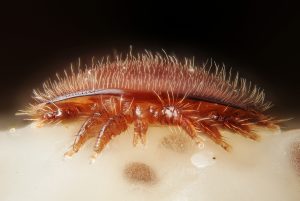
Australia was the last major honey producing country to be free of the pest before the outbreak. ShareAlike 2.0 Generic (CC BY-SA 2.0)
An invasive parasite deadly to bees has been detected in central west NSW for the first time.
Key points:
- Varroa mite has been detected at Gumble near Molong, with 23 hives already destroyed
- The hives were legally moved to the area from Sackville North in Sydney and traced to the area as part of the ongoing containment effort
- Local beekeepers remain confident the outbreak can be contained
The Department of Primary Industries has euthanized 23 hives at Gumble near Molong that tested positive to varroa mite after tracing their movement from Sackville North in Sydney.
The department said the movement was legal but was then followed up after a detection in the Sydney region.
The outbreak started at the Port of Newcastle last year and has since been found in almost 200 hives across the Central Coast, Hunter, and Sydney basin.
DPI deputy incident controller Shannon Mulholland said the fact the detection was made so quickly showed the biosecurity measures were working.
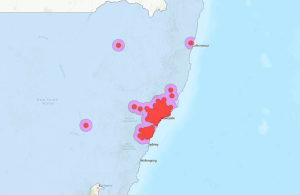
The latest detection is the first time varroa mite has been found in the NSW central west. Map can be found at https://www.dpi.nsw.gov.au/emergencies/biosecurity/current-situation/varroa-mite-emergency-response
“The site has already been euthanized so by acting on that quite quickly we were able to get on top that situation and work to further mitigate spread of the mite,” she said.
Australia was previously the only major honey producing country in the world free of the mite before the outbreak in Newcastle.
The pest is known to weaken and kill colonies of honey bees but can also transmit deadly viruses between hives.
In the last 12 months more than 130,000 hives have been tested for the parasite, with more 25,000 destroyed, according to the DPI.
Local producers confident
The central west was previously a blue zone, meaning it was in the general emergency zone but not in any eradication or surveillance areas.
Despite the fresh outbreak, local honey producer John Lockwood remained confident the ongoing incursion could be contained.
“It is slowly spreading through the Central Coast which is a concern, I do believe they have a ring around it which is fantastic that they’ve found the outer edge and have it contained,” he said.
“This one at Gumble is from a legal hive movement and there is very low [numbers of] mite in the colonies so it is just a spot fire I believe.”
However, the president of Crop Pollination Australia Steve Fuller said the detection of varroa mite was “very concerning”.
“The problem is it is blue zone to blue zone [transmission], that is where the industry is really worried,” he said.
“If it was an illegal movement, industry would be a lot happier.”
A 10-kilometre eradication zone has been established around the discovery at Gumble where all hives will be euthanized.
A 25km surveillance zone has also been established where officials will be monitoring both domestic and wild honey bee colonies.
We are here to share current happenings in the bee industry. Bee Culture gathers and shares articles published by outside sources. For more information about this specific article, please visit the original publish source: Varroa mite detected in central west NSW but honey producers remain confident – ABC News
]]>Honey bees aren’t an endangered species; they’re causing chaos
Yes, everyone loves them and keeping them has become a green hobby, but they’d feel differently if a swarm besieged their home

Antonia Hoyle: ‘I frantically vacuumed them up and deposited them outside as fast as they arrived’ CREDIT: Geoff Pugh for The Telegraph
For days, there were only a few, upstairs – blown in through a window, I assumed, by the late spring breeze. But then more came downstairs, gaining ominously in number until one morning three weeks ago, I walked into the living room to find hundreds of the creatures crawling, seemingly lethargic, over the carpet.
“Wasps!” I wailed to my analyst husband, Chris, who like me is 44. I frantically vacuumed them up and deposited them outside as fast as they arrived, until the pest controller arrived at our location home. Pointing at a cloud of black dots dancing around our third-floor chimney, he corrected me: “You’ve got honey bees.”
Being gatecrashed by sugar plum fairies would have been simpler, and less controversial, to navigate. While not illegal, pesticides permitted to treat honey bees in a domestic setting are strictly limited, ethically questionable, and some pest controllers refuse to deploy them.
Short of advising us to stuff the fireplaces they’d been flying in through, and spend hundreds hiring a cherry picker to send someone up to the roof to physically extract them (with no guarantee of success) there was little he could do, the pest control man apologised, letting us know, for what it was worth, that we are far from alone.
This month beekeepers reported an increase in honeybee swarms – which happen when the old queen departs the hive with half the bees to set up a new home – caused by the sudden change in weather after a long, cold spring.
Usually, this split happens in a “staggered manner,” explains Matthew Richardson, president of the Scottish Beekeepers’ Association, but because of the delay in decent weather “the bees have been queuing up waiting to swarm and they’re all going at once.”
For many, the image might gladden the heart. Chris’s eyes certainly softened when I disclosed the identity of our uninvited guests and our 12-year-old daughter Rosie was delighted: “They’re an endangered species!”
But are they? In recent years, wildlife campaigners have made huge efforts to raise awareness of the importance of bees, of which there are around 270 species in the UK, including 24 species of bumble bees and hundreds of wild solitary bees that nest alone in cavities or underground.
Many are in decline – we have already lost around 13 species, including the short-haired bumblebee, last recorded in 1956, and the great yellow bumblebee in 1974. Another 35 species are currently at risk, with the use of pesticides in farming and destruction of pollen and nectar to feed off largely to blame – the UK has lost 97 per cent of its wildflower meadows since the 1930s.
Concern around honey bees, however, seems to stem from 2007, when an unexplained condition called colony collapse disorder (CCD), in which worker bees in a honey bee colony disappear, was officially recognised. Colony losses were reported in America and Europe and the potential impact on agriculture – according to the United Nations’ Food and Agriculture Organization (FAO), the global value of global crops pollinated by honey bees in 2005 was estimated at over £150bn – was huge.
Within a decade, the threat of CCD seemingly passed, but our passion for honey bees continued, often in cities where beekeeping has become a fashionable “green” hobby. In 2021 UK Google searches for “urban beekeeping” jumped 21 per cent in a year. Celebrities who keep bees, meanwhile, include David Beckham and Jeremy Clarkson and last month a picture of the Princess of Wales wearing a beekeeper’s suit while tending to a hive in her Norfolk estate was released to mark World Bee Day.
“There’s definitely a popular misconception around bees,” says Andrew Whitehouse of insect conservation charity Buglife, who says honey bees are “not endangered, they’re essentially livestock” and believes misunderstandings began when charities such as his own started to raise awareness of the importance of all pollinating insects around 20 years ago: “Perhaps the conservation organisations didn’t explain things properly and well-meaning people reached for the solution which was to increase the number of honey bees.”
At the same time as charities were starting to promote the importance of “wild pollinators,” he adds, CCD was becoming widely known: “I think the two issues were conflated a bit.”
Because honey bees are good at collecting pollen and returning it straight to their hives, they are less efficient at pollinating some plants than wild bees, with whom they compete for pollen. And honey bee hives are bigger than most……
To read the complete article go to;
Honey bees aren’t an endangered species; they’re causing chaos (telegraph.co.uk)
We are here to share current happenings in the bee industry. Bee Culture gathers and shares articles published by outside sources. For more information about this specific article, please visit the original publish source: Honey bees aren’t an endangered species; they’re causing chaos (telegraph.co.uk)
]]>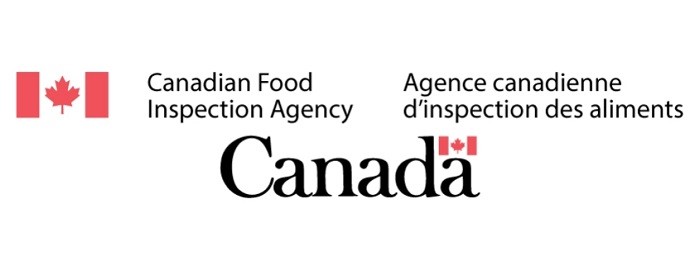 The Canadian Food Inspection Agency (CFIA) will be undertaking a new risk assessment to evaluate the risks associated with the importation of honey bee packages from the United States. The risk assessment will be conducted based on guidelines provided by the World Organisation of Animal Health (WOAH) and is expected to be completed by early next year. Should you wish to submit any new scientific information related to the health of honey bees or control programs in place to control disease agents and pests in Canada or in the United States, please send these to the CFIA at [email protected], by August 31, 2023, at the latest.
The Canadian Food Inspection Agency (CFIA) will be undertaking a new risk assessment to evaluate the risks associated with the importation of honey bee packages from the United States. The risk assessment will be conducted based on guidelines provided by the World Organisation of Animal Health (WOAH) and is expected to be completed by early next year. Should you wish to submit any new scientific information related to the health of honey bees or control programs in place to control disease agents and pests in Canada or in the United States, please send these to the CFIA at [email protected], by August 31, 2023, at the latest.
The CFIA is committed to its mandate to protect animal health, which includes the health of the Canadian bee population. The CFIA will continue to engage with the Canadian Honey Council, the USDA, provincial governments and apiculturists and a wide range of other stakeholders with respect to Canadian honeybee health.
In addition, the CFIA continues to put significant effort into identifying and evaluating potential new sources of packaged bees and queen bees internationally. Canada currently allows imports of honey bee queens from the United States, Chile, Australia, New Zealand, Denmark, Ukraine, Italy and Malta, and honey bee packages from Ukraine, Italy, Chile, Australia and New Zealand.
Sincerely,
Parthi
Dr. Parthi Muthukumarasamy (he, him, il)
Executive Director, International Programs Directorate
Canadian Food Inspection Agency / Government of Canada
[email protected] | 343-550-3542
Directeur exécutif, Direction des programmes internationaux
Agence canadienne d’inspection des aliments / Gouvernement du Canada
[email protected] | 343-550-3542
]]>Winston Szeto · CBC News
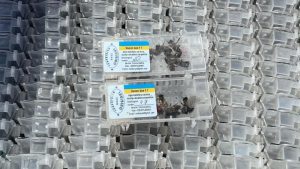
The owner of Rushing River Apiaries in Terrace, B.C., announced last week that it had acquired 200 Carpathian queen bees from Ukraine. (Rushing River Apiaries)
A city in B.C.’s North Coast has become a buzzing haven for unique new visitors courtesy of a local beekeeper.
Christine McDonald, owner of Rushing River Apiaries in Terrace, B.C. — about 575 kilometres west of Prince George — recently took to social media to share her delight over the arrival of 200 Carpathian queen bees and 1,000 accompanying worker bees to her farm from Ukraine, through a beekeeping equipment company in Ontario.
McDonald says she acquired 200 plastic cages of the queen bees, each also containing five worker bees and food.
“I knew that these Carpathians are well known for their rugged survival like mountain honey bees, and also being very gentle,” McDonald told host Carolina de Ryk on CBC’s Daybreak North.
“Those are the two qualities that we value a lot, especially because we sell these to newer beekeepers, and we want them to be able to comfortably work with their bees.”
Imports to Canada since 2020
The Carpathian bees get their name from the Carpathian Mountains, a 1,500-kilometre range spanning Central and Eastern Europe from the Czech Republic to Romania.
Alison McAfee, a honey bee specialist at the University of British Columbia, says Ukraine has a thriving beekeeping industry involving over 600,000 people — approximately 1.5 per cent of the country’s population — working with apiaries. Ukraine ranks among the top five honey exporters globally in terms of weight.
In 2020, the Canadian Food Inspection Agency (CFIA) granted approval for Ukraine to export queen bees to Canada.
Prior to Russia’s invasion in 2022, which devastated apiaries throughout Ukraine and displaced tens of thousands of beekeepers, the CFIA also authorized the importation of bee packages consisting of a queen bee, several thousands of worker bees, and a brood of larvae in a hive box.
The federal agency says it has issued six permits for importing queen bees from Ukraine this year so far, and some permit holders distribute the bees to apiaries across Canada.
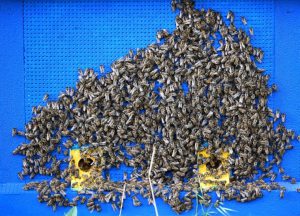
Bees are pictured in June 2022 at an apiary outside Melitopol, Ukraine. (Yuri Kadobnov/AFP via Getty Images)
Dancing Bee Equipment, based in Port Hope, Ont., is among distributors of Carpathian queen bees. Individual buyers must travel to Ontario to collect the bees at the airport or the company’s warehouse, while commercial buyers can request a shipment of the bees.
CEO Todd Kalisz says the company has imported over 20,000 queen bees from Ukraine since the start of the war, acknowledging the logistical challenges caused by the ongoing conflict.
“There’s no advance notice of the [shipping] schedule … it could change the day after,” he said, adding some customers who failed to check the updated schedule were disappointed after making the long drive to Ontario, only to discover their orders hadn’t arrived.
We are here to share current happenings in the bee industry. Bee Culture gathers and shares articles published by outside sources. For more information about this specific article, please visit the original publish source: Queen bees from Ukraine find a sweet new home in northwestern B.C. | CBC News
]]>Beekeeping is an Example
NEWS PROVIDED BY
CGTN (Chinese Global Television Network)
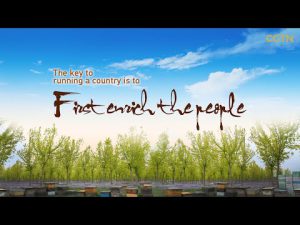
BEIJING /PRNewswire/ — Liu Jinliang, a second-generation beekeeper in Miyun District, the northeastern suburb of Beijing, practices multi-box beekeeping. He is China’s first beekeeper to successfully utilize the technique, introduced by the district government in 2016.
It took the young bee farmer five years to fully implement the new technique, and now it is helping his family and local beekeepers live a “sweet” life.
Spurred on by Liu and the local government, around 30 percent of bee farmers in Miyun have now adopted the new technique, greatly boosting the output and quality of their honey. Over 360 low-income farmers in Miyun have shaken off poverty since joining the beekeeping project.
“Through my example, I can motivate people around me. And those people can empower other people around them as well. In this way, we can achieve common prosperity,” Liu told CGTN.
The beekeeping industry in Miyun generated around 130 million yuan ($18.91 million) in revenue in 2020, an increase of 19.3 percent over 2019. Encouraged by what has been achieved in Miyun, more and more bee farmers across China have turned to the multi-box beekeeping technique to raise their honey output while improving quality.
Chinese President Xi Jinping once quoted an ancient Chinese proverb, “The key to running a country is to first enrich the people,” to explain why the country is striving for common prosperity. Liu’s story gives a glimpse of China’s exploration of the paths to achieve that goal.
People-centered philosophy
The saying, which comes from Shiji, or Records of the Grand Historian, a monumental history book of ancient China compiled about 2,000 years ago, sets forth the traditional Chinese philosophy of governance: the common people are considered the foundation of a country, and only when the people prosper can the country prosper.
This is a classic piece of Chinese wisdom, and it has become part of the governance philosophy of the Chinese government in modern times.
When quoting the saying at a gathering to mark China’s poverty alleviation accomplishments and honor model poverty fighters, President Xi pledged the country would adhere to the people-centered development philosophy and unswervingly follow the path of common prosperity.
“We have always remained committed to standing on the side of the people and consistently stressed that eradicating poverty, improving people’s lives, and achieving common prosperity represent the essential requirements of socialism,” said Xi.
Behind Liu’s success is the Miyun district government. It has helped local beekeepers learn advanced apiculture techniques and provided them with high-quality queen bees at no charge.
To better help beekeepers, the district government has also provided financial aid to support about 30 projects in the sector, with an investment of about 100 million yuan, to help make commercial beekeeping standardized and industrialized.
Video – https://www.youtube.com/watch?v=Lom4HnpR2xI
SOURCE CGTN
We are here to share current happenings in the bee industry. Bee Culture gathers and shares articles published by outside sources. For more information about this specific article, please visit the original publish source: CGTN: Why does China stick to the path of common prosperity? (prnewswire.com)
]]>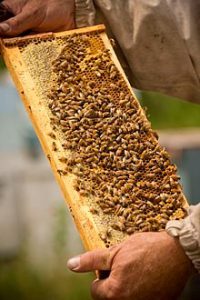 Without bees, there is no food, so keeping hives healthy is of utmost importance. That job is becoming more difficult thanks to an outbreak of disease and the effects of climate change.
Without bees, there is no food, so keeping hives healthy is of utmost importance. That job is becoming more difficult thanks to an outbreak of disease and the effects of climate change.
That’s where special apiary inspectors come in, who check on the health of keepers’ bees to help prevent the spread of honeybee diseases and pests.
Marie Cairns, a bee keeper who runs a small apiary in the Cowichan Valley, had her hives checked on Friday by Tara Galpin, an apiary inspector for South Vancouver Island and the Gulf Islands.
“First of all, it was all about the pollination, but then the more you learn about bees the more fascinating they are,” Cairns said.
Cairns has been bee keeping in the valley for nine years. She got her inspection for free, as any bee keeper can, so she can sell some of her hive.
“You have bees and you want your own bees to stay healthy, so you want their bees to be healthy because they fly and bring back disease if you don’t or mites or anything else,” she said.
Galpin is looking for a few different diseases and pests. One that comes up often is the varroa mite, a parasitic mite that feeds on honey bees and causes a disease called varroosis.
“They feed out the fat body of the bee, so it’s like if we had the size of a rat on our human body feeding on our liver,” Galpin explained.
Unfortunately, Cairns’ bees had too many mites. “My first time failing,” she said.
But this experienced bee keeper is unfazed, and will work with the inspector to apply the appropriate treatment.
Galpin says unpredictable spring weather due to climate change—that have been cooler and damper—is helping to spread fungal disease and doesn’t allow bees to forage for food when they need it most.
Keeping bees in good shape is important, as along with other native pollinators they play a key role in sustaining B.C.’s food system, and contribute an estimated $250 million to the province’s economy.
The inspector says losses this year in bee colonies is between 30 to 40 per cent—climate change and the spread of disease keeping the pressure on bees and their keepers.
“More than anything, we need diversity of plants for our bees to forage from and diversity in our food landscapes,” she said.
Importing bees plays a major role in maintaining the bee population across Canada, and combined with the work of inspectors like Galpin, they’re ensuring bees keep food on our table.
We are here to share current happenings in the bee industry. Bee Culture gathers and shares articles published by outside sources. For more information about this specific article, please visit the original publish source: Disease and climate change put pressure on bees and their keepers: apiary inspector | CTV News
]]> Irelands Minister Hackett launches the National Apiculture Programme 2023 – 2027
Irelands Minister Hackett launches the National Apiculture Programme 2023 – 2027
From Department of Agriculture, Food and the Marine
The Minister of State in the Department of Agriculture Food and the Marine, Senator Pippa Hackett, today launched the National Apiculture Programme supporting the Beekeeper Sector in Ireland.
Launching the Programme the Minister said:
“I am delighted to announce the introduction of the new National Apiculture Programme which will run until the end of 2027. This Programme, which supports research into production standards, demonstrates my department’s continued support to the beekeeping sector in Ireland.”
Support for beekeeping is provided through National Apiculture Programmes which aim through approved applied research projects to improve the general conditions for the production of honey and other apiculture products in the EU. Researchers are invited to submit proposals for the new National Apiculture Programme which will run until 31 December 2027.
The aims of the programme are to:
- provide technical assistance to beekeepers
- combat beehive invaders and diseases, particularly varroasis
- co-operate with specialist bodies for the implementation of applied research programmes in the field of beekeeping and apiculture products
All suitable bodies that can demonstrate the necessary research capabilities, including Universities, Institutes of Technology and Teagasc, are eligible to submit proposals. Projects that involve collaboration between institutions and/or involve the development of critical mass are encouraged.
The deadline for receipt of applications for this call is Friday 30 June 2023. Queries relating to the National Apiculture Programme 2023-2027 can be emailed to [email protected]
We are here to share current happenings in the bee industry. Bee Culture gathers and shares articles published by outside sources. For more information about this specific article, please visit the original publish source: gov.ie – Minister Hackett launches the National Apiculture Programme 2023 – 2027 (www.gov.ie)
]]>by Scarlett Howard, Alexander Mikheyev, Emily Remnant, Simon Tierney and Théotime Colin, The Conversation
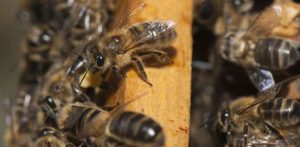
Credit: Théotime Colin, Author provided Varroa mites—notorious honey bee parasites—have recently reached Australian shores, detected at the Port of Newcastle in New South Wales last year. If they establish here, there would be significant implications for agricultural food security, as honey bees are heavily relied on for the pollination of many crops.
However, while Australia is the last continent to be invaded by the mite, it has an opportunity to be the first to eradicate it.
Varroa destructor is a small mite that attaches to bees and eats their “fat body.” The fat bodies of honey bees are the insect equivalent of a liver. Varroa weakens bees, reduces their lifespan and increases the spread of deadly viruses.
Scientists need to be ready: this might be Australia’s best chance to collect important data on the spread and evolution of this parasite. Our new paper published today in Biology Letters outlines what questions scientists need to ask and what data they need to collect if Varroa spreads in Australia.
Such data could help us understand how parasites evolve, why Varroa are so damaging for honey bees, and how Varroa mites impact other insects and the environment.
Will Varroa establish in Australia?
Australia is in close proximity to countries that have the mite, including New Zealand, Papua New Guinea, Timor-Leste and Indonesia.
This probably explains why invasive honey bee swarms are frequently intercepted at our ports, many of these carrying Varroa. Australia currently bans importation of honey bee colonies due to the biosecurity risk, so these interceptions are typically due to stowaway swarms taking up residence in shipping containers.
Previous invasions of Varroa have been successfully eradicated before establishing, but this time Varroa circumvented the biosecurity surveillance near Newcastle and spread locally.
The New South Wales Department of Primary Industries has been contact-tracing and culling hives in contaminated areas, and the spread has been slow so far. Australia has large populations of feral honey bees, which could potentially act as a reservoir for Varroa and are much harder to trace and control, so the department is tackling this with a wild honey bee baiting program.
What threats does Varroa pose?
Varroa mites are a threat to food security. Although Australia has an abundance of food and exports it to other nations, the price of food is likely to increase if Varroa escapes confinement.
Currently, pollination of crops in eradication zones such as berries in Coffs Harbor is at risk due to the removal of all honey bees in the region, which may lead to short-term increases in food costs.
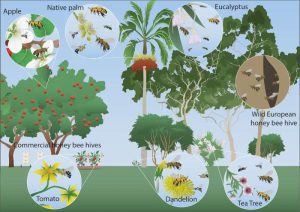
Australia currently relies on pollination by commercial honey bees (yellow), supplemented by feral honey bees (brown), though we have many native bee species like stingless bees and blue banded bees that are also being used in crop pollination. Credit: Boris Yagound, adapted from Chapman et al. 2023, CC BY
However, establishment and spread of Varroa will lead to lower pollination and lower crop production across the country, which will raise the price of most fruit and vegetables that depend on bee pollination.
This could worsen the food affordability crises caused by the current inflation, affecting the ability of low income households to buy nutritious and fresh produce. Almond pollination has already noted a deficit of 80,000 hives in the last season.
Many of the honey bee colonies that pollinate our crops are thought to be feral, living in tree hollows or nest-boxes designed for native animals. These feral bees are not managed by beekeepers and so won’t be saved by the use of Varroa treatments, meaning they will most likely disappear.
To read the complete article go to; Opinion: Australia is in a unique position to eliminate the bee-killing Varroa mite. Here’s what happens if we don’t (phys.org)
We are here to share current happenings in the bee industry. Bee Culture gathers and shares articles published by outside sources. For more information about this specific article, please visit the original publish source: Opinion: Australia is in a unique position to eliminate the bee-killing Varroa mite. Here’s what happens if we don’t (phys.org)
]]>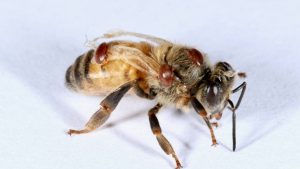
Varroa mites are responsible for the loss of tens of thousands of hives in New Zealand each year, killing countless bees like this one. Photo / Supplied
A destructive mite plaguing our beekeeping industry may have been building up home-grown resistance to a widely used chemical pesticide, a new study suggests.
Flumethrin has long been a key tool for controlling varroa, but when researchers recently assessed its mite-killing performance at one apiary, they found concentrations of it needed to be 13 times higher than two decades ago.
They say the findings, just released ahead of peer review, warrant further investigation to see if miticide resistance is a wider, hidden problem for the $5 billion industry.
Since being first detected back in 2000, the varroa destructor mite has become the sector’s biggest headache, each year accounting for nearly half of colony losses and costing more than $1 million in mitigation efforts and lost honey production.
The new study, led by PhD student Rose McGruddy and co-authored by Lester, focused on two key chemical pesticides used for varroa control.
They were flumethrin and amitraz – estimated to be used by 78 and 85 per cent of commercial beekeepers respectively.
Typically, they applied one product in early spring, and another in late summer or early autumn.
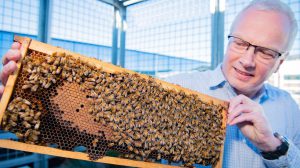
“Mite resistance to flumethrin may help explain why the mite problem is getting worse,” Victoria University ecologist Professor Phil Lester says. Photo / Supplied
“We’ve heard differing reports of the effectiveness of chemical pesticides, especially flumethrin,” Lester said.
“The nationwide survey and Rose’s data suggest most beekeepers are satisfied with it.
“But there are others who think this product is much less effective than it used to be – some even stating it has failed to control varroa entirely.”
Unlike in the past, some beekeepers were now using more than two applications of it, he said.
In the study, the researchers drew on years of survey data, along with their own laboratory tests of pesticides.
“The key result was that we found that the concentration of flumethrin needed to kill mites was 13-times higher than it was in 2005,” Lester said.
“This result indicates that mites appear to have and are developing resistance to this chemical.”
There was no evidence of any resistance to amitraz, which is another key pesticide for mite control, as it appeared to be effective, he said.
The study team stressed this result didn’t mean that commercial products containing flumethrin didn’t work – and they might still be useful for mite control for many beekeepers.
“We’d also note that the mites we used for this work were from the Wellington region and we can’t be sure that selection for resistance has occurred everywhere equally,” he said.
“But the big implication is that resistance does seem to have developed. It could explain the limited success of control using flumethrin reported to us by beekeepers.
“Mite resistance to flumethrin may help explain why the mite problem is getting worse.”
While varroa resistance to the chemical had been observed around the world, the study team didn’t find any of the same genetic markers of resistance identified in overseas studies.
“The New Zealand resistance development seems to be via a different pathway for the New Zealand population of mites,” Lester said.
The study raised several questions that urgently needed answering: namely, whether such “home-grown” was occurring more widely and, if so, how.
More broadly, Lester felt new products were needed for mite control, with novel modes of action – such as new “gene-silencing” approaches his own group was researching.
“We need to carefully manage resistance, by ensuring good integrated pest management procedures, which include alternating control methods,” he said.
“New methods are desperately needed.”
The industry’s peak body, Apiculture New Zealand, also said the study’s findings needed to be interpreted with caution.
“Because there has been growing discussion that resistance to treatments may be an issue in New Zealand, this research is of interest,” it told the Herald in a statement.
“However, although these lab concentrations differ to what was detected in 2003, they remain lower than what was detected in international apiaries with resistant varroa.
“Additionally, we note that the varroa tested in this research was collected from one apiary so it may not represent all regions.”
The group said this needed to be fully tested before any conclusions could be made regarding chemical resistance.
“As outlined by the researchers and by ApiNZ and our experts, the key to varroa management is ensuring the control methods are conducted as per label and rotated between treatment groups,” it said.
“Untreated colonies die. This does not change.”
We are here to share current happenings in the bee industry. Bee Culture gathers and shares articles published by outside sources. For more information about this specific article, please visit the original publish source: Has the destructive varroa been building ‘home-grown’ pesticide resistance in NZ? – NZ Herald
]]>